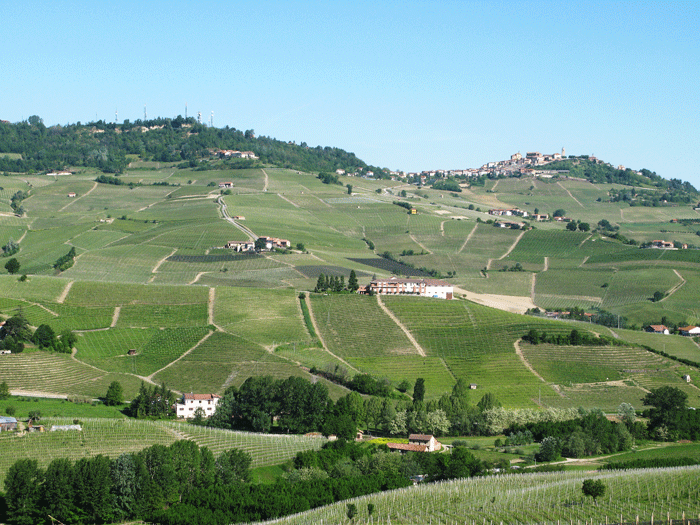Barolo’s “Cannubi”: historical integrity or commercial ‘necessity’? The case and confusion continues
Author: David Berry Green

The heart of the matter: Barolo Cannubi, the historical vineyard between Viganò and the ex-vineyard of Canonica
Just when you thought that the recently launched menzioni geografiche aggiuntive or sottozone (subzone) delineation of the Barolo (and Barbaresco) vineyards had been concluded with the release of the 2010 Barolo vintage, probably the most famous case – that of where Barolo’s Cannubi vineyard starts and finishes – has now, since 3 April, been referred to Rome’s court of Cassazione (supreme appeal court) for a final judgment; a process due to last six years. This last step has been taken by five producers/owners: Brezza, Luciano Sandrone, Fratelli Serio & Battista Borgogno, Tenuta Carretta and Bartolo Mascarello, and supported by two proprietors Pietro Scarzello (ex. Marchesi di Barolo S.P.A.) and Michelina Fontana. The key question is: will this higher court respect historic toponymy or cede to commercial pressure?
In October 2013, Rome’s Consiglio di Stato – the high administrative court – overturned a previous judgment regarding the Cannubi vineyard. The court found in favour of Marchesi di Barolo S.P.A., supporting the case that its consumers might be confused into thinking that the Barolo Cannubi Muscatel vineyard (of which it owns 90 percent) might be the source of white Muscat grapes not of Nebbiolo, thereby enlarging the single 15ha vineyard of Cannubi to incorporate an entire hill (of 34ha). In its summing up, Rome’s Consiglio di Stato revealingly recognised the rights of the owners of the original Cannubi site and recommended that they refer to the Consorzio of Barolo and Barbaresco, conspicuously absent as ever, for a special dispensation and name for their vineyard. (DBG: Cannubi di Cannubi?!)
What’s clear from one of the definitive documents on the subject of vineyard delineation in Barolo, the original 1990 Arcigola edition of Atlante delle Grandi Vigne di Langa (Comune di Barolo), which draws on information from Lorenzo Fantini’s study (1883), Ferdinando Vignolo Lutati (1920) and Renato Ratti’s “Carta del Barolo” (1972), is that while la collina (the hill) of Cannubi is cited as a “sottozona viticola storica di tradizionale vocazione”, a recognised historical zone traditionally vocated (Ratti), the heart of the hill is located by all interviewed as lying between the Viganò propriety (now owned by Einaudi) and the ex-vineyard of the Canonica family in front of the cemetery. This area correlates with Cannubi’s location and status of 1er Categoria – the best zones with elevated quality characteristics – identified by Ratti in his Carta del Barolo, quite distinct from the zones attributed to Cannubi Muscatel and Cannubi Boschis, vineyards marked only as having “particular qualitative characteristics”.
Tellingly, under the entry “Valletta or Cannubi Valletta”, the Atlante sympathises with the reasoning behind extending the name of Cannubi to that of its neighbours, but they recommend explicitly that the second appellation (Cannubi Muscatel, Cannubi Valletta, Cannubi San Lorenzo, Cannubi Boschis) should not be lost/removed, in order to provide honest information to the consumer (“and to wine appassionati around the world.”) Just imagine the furore if the Burgundians authorised that “Chambertin” could be used in place of Charmes-Chambertin, Mazis-Chambertin, Chapelle-Chambertin, Latricieres-Chambertin etc…
So as it currently stands, the Marchesi di Barolo S.P.A. has won the right, apparently for reasons of commercial expediency, to apply the term “Cannubi” for all 2010 vintage fruit coming from a hill of vines (and beyond?), now over twice the size of the original, historical vineyard. This surely sets a precedent by which any vineyard close to La Collina di Cannubi has a right in future to call their wine “Cannubi”. Ironically, instead of helping to inform and protect consumers, this present situation only serves to further confuse them as to what really constitutes “Barolo Cannubi”. Consumers beware!



solo i vecchi cannubi devono essere rispettati e confermati nel suo origine i terreni vicini mantengano le vecchie caratteristiche rispettando le tradizioni
Sono d’accordo con Ferraro. Il nome della proprietà perde ogni significato se è esteso e modificato dai tribunali.